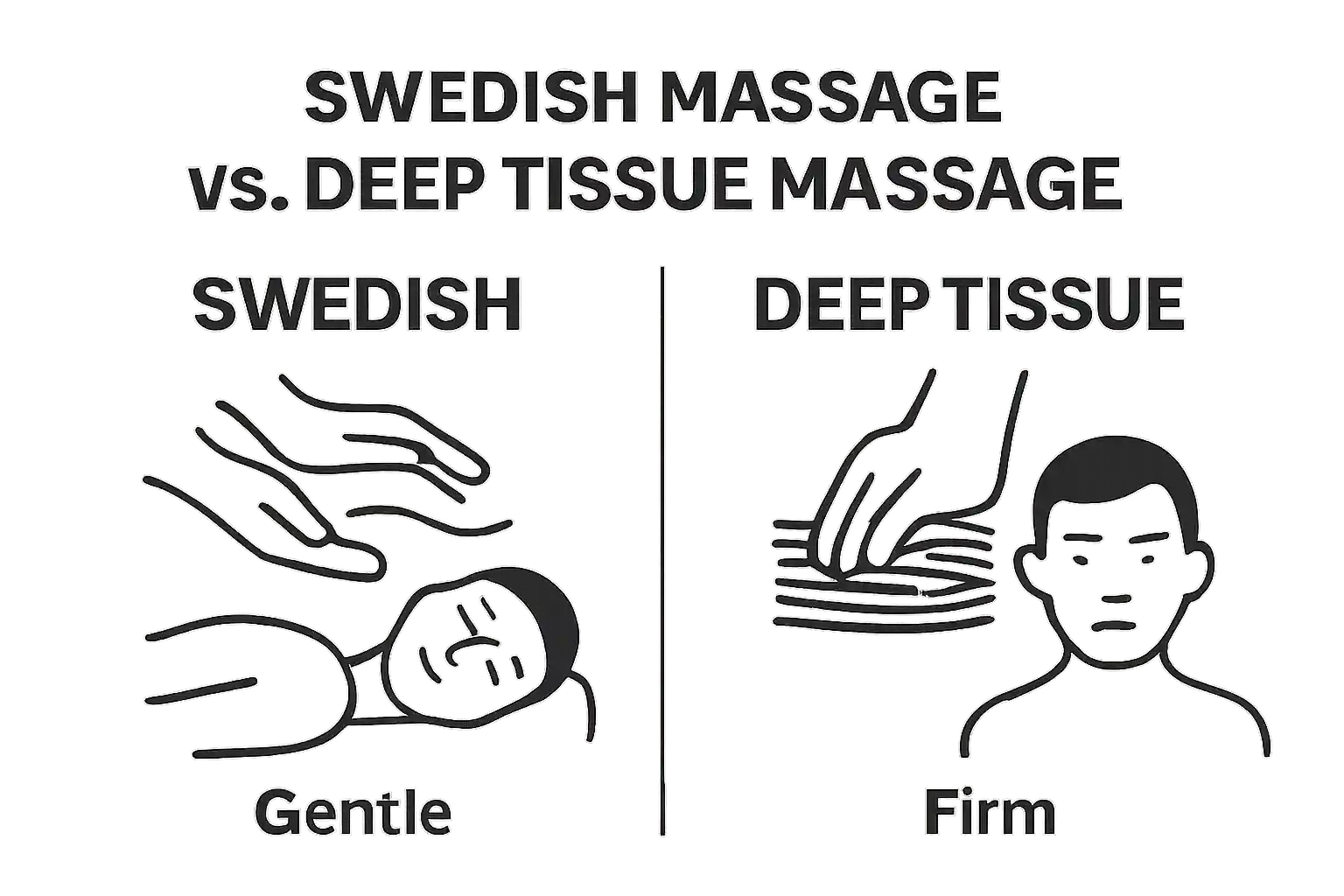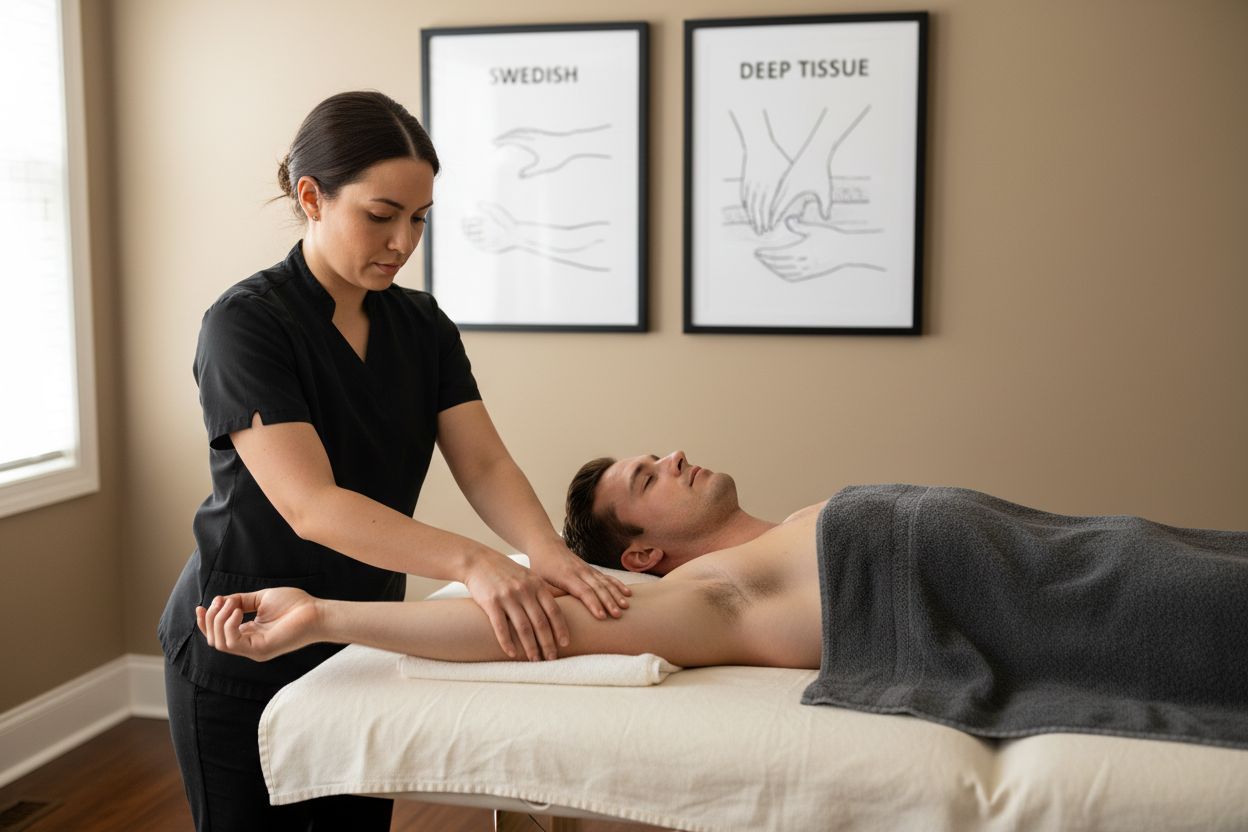Massage therapy is much more than a relaxing treat. Over 47 million Americans get massages every year for reasons that go way beyond stress relief. Most people think of it as a luxury, but the real surprise is how deeply massage therapy can transform both physical and emotional health at the same time.
Table of Contents
- What Is Massage Therapy And Why It Matters
- The Key Techniques Of Massage Therapy Explained
- How Massage Therapy Works On The Body
- The Benefits Of Different Massage Styles
- Understanding The Role Of A Massage Therapist
Quick Summary
| Takeaway | Explanation |
|---|---|
| Massage therapy improves physical health. | Systematic manipulation of soft tissues supports healing by reducing muscle tension, enhancing circulation, and speeding recovery from strain. |
| Regular massages enhance emotional wellness. | Massage therapy lowers stress hormones and increases feel-good neurotransmitters, improving mood and reducing anxiety over time. |
| Choose the right massage technique for your needs. | Different techniques, like Swedish and deep tissue, target specific issues; selecting the right one can maximize therapeutic benefits. |
| Massage therapists provide personalized care. | Skilled therapists assess individual health needs and create tailored treatment plans, ensuring safe and effective interventions for each client. |
| Understanding physiological responses is key. | Knowledge of how massage affects the body helps clients appreciate its benefits, transforming tension into relaxation and promoting healing. |
What is Massage Therapy and Why It Matters
Massage therapy is a holistic healing practice that involves systematic manipulation of soft body tissues to promote physical and mental wellness. At its core, this therapeutic approach uses skilled hand movements to address muscle tension, reduce stress, and support overall health. Research from the National Center for Complementary and Integrative Health confirms that massage therapy goes far beyond simple relaxation.
The Physical Mechanics of Massage
When a massage therapist applies targeted pressure and movement to muscles, ligaments, and connective tissues, several remarkable physiological responses occur. These techniques stimulate blood circulation, encourage lymphatic drainage, release muscle tension, and trigger the body’s natural healing mechanisms. By applying strategic pressure and movement, massage therapists can help reduce inflammation, improve flexibility, and accelerate recovery from physical strain.
Mental and Emotional Benefits
Beyond physical relief, massage therapy profoundly impacts mental and emotional wellbeing. According to Mayo Clinic studies, regular massage sessions can significantly reduce stress hormones like cortisol while increasing feel-good neurotransmitters such as dopamine and serotonin. These neurochemical changes contribute to reduced anxiety, improved mood, and enhanced overall emotional balance.
Massage therapy offers comprehensive benefits that extend well beyond temporary comfort. By addressing both physical tension and mental stress, this therapeutic approach represents a powerful tool for holistic wellness. For those interested in understanding more about our therapeutic approaches, our expert practitioners are dedicated to personalized healing strategies that support your unique health journey.
The Key Techniques of Massage Therapy Explained
Massage therapy encompasses a diverse range of techniques designed to address different physical and emotional needs. Each method offers unique benefits, targeting specific muscle groups, tension patterns, and wellness goals. According to Mayo Clinic research, understanding these techniques helps individuals select the most appropriate approach for their personal health requirements.
Swedish and Deep Tissue Massage
Swedish massage represents the foundation of Western massage therapy, characterized by long, flowing strokes that promote overall relaxation and improve circulation. Deep tissue massage, in contrast, applies more intense pressure to reach deeper muscle layers and connective tissues. These techniques differ primarily in pressure and intent: Swedish massage focuses on gentle, broad movements, while deep tissue massage targets chronic muscle tension and knots with firmer, more focused pressure.
 The key difference lies in the therapeutic goals – Swedish massage aims for general relaxation, whereas deep tissue massage addresses specific muscular issues and chronic pain.
The key difference lies in the therapeutic goals – Swedish massage aims for general relaxation, whereas deep tissue massage addresses specific muscular issues and chronic pain.

Specialized Massage Techniques
Beyond traditional approaches, several specialized massage techniques offer targeted healing. Trigger point therapy concentrates on specific muscle knots that cause referred pain in other body areas. Myofascial release works on the connective tissues surrounding muscles, helping to restore movement and reduce tension. Lymphatic drainage massage uses gentle movements to stimulate the lymphatic system, supporting immune function and reducing swelling. For those curious about our comprehensive approach, explore our stretch and restore services to understand how we integrate these techniques for holistic wellness.
Each massage technique requires specialized training and understanding of human anatomy. Skilled massage therapists assess individual client needs, combining different methods to create personalized treatment plans that address specific physical and emotional challenges.
To help you understand the unique characteristics of core massage techniques, the table below compares Swedish, Deep Tissue, and Specialized Massage approaches, highlighting pressure, focus, and key benefits.
| Massage Technique | Pressure | Focus Area | Key Benefits |
|---|---|---|---|
| Swedish Massage | Light to moderate | Whole body, muscles, circulation | Relaxation, improved circulation, reduced stress |
| Deep Tissue Massage | Firm, deep | Deeper muscle layers, connective | Reduced chronic pain, targets muscle knots, aids recovery |
| Trigger Point Therapy | Targeted, firm | Specific muscle knots (trigger pts) | Relieves referred pain, breaks chronic tension patterns |
| Myofascial Release | Gentle to firm | Connective tissue (fascia) | Increases flexibility, releases tension, restores movement |
| Lymphatic Drainage Massage | Very gentle | Lymphatic system, soft tissues | Boosts immune function, reduces swelling and inflammation |
How Massage Therapy Works on the Body
Massage therapy triggers a complex series of physiological responses that transform how our body manages stress, tension, and healing. Research from the National Center for Complementary and Integrative Health reveals that these therapeutic techniques impact multiple body systems simultaneously, creating a holistic healing experience.
Neurological and Muscular Responses
When massage therapists apply targeted pressure and movement, they stimulate nerve receptors throughout the body. These receptors communicate with the central nervous system, triggering responses that can reduce pain perception, lower stress hormones, and promote relaxation. Muscle tissue responds by releasing tension, improving flexibility, and increasing blood flow. Specific nerve stimulation can interrupt pain signals, allowing muscles to relax and recover more efficiently.
This neurological communication is critical in transforming physical tension into a state of comfort and healing.
Circulatory and Immune System Interactions
Massage therapy dramatically influences the body’s circulatory and lymphatic systems. Skilled manipulation of soft tissues encourages enhanced blood circulation, which delivers oxygen and nutrients more effectively to muscle groups and removes metabolic waste products. The lymphatic system receives similar benefits, with gentle massage techniques supporting immune function and reducing inflammation. Improved circulation supports faster muscle recovery and helps the body eliminate toxins more efficiently. For clients interested in understanding how we integrate these principles, explore our deep tissue massage techniques that target specific physiological responses.
Understanding these intricate bodily responses demonstrates that massage therapy is far more than a simple physical treatment. It represents a sophisticated interaction between touch, nervous system communication, and the body’s natural healing mechanisms.
The following table details the main physiological responses and system interactions that occur during massage therapy sessions, summarizing how each body system is positively affected.
| Body System | Response to Massage | Resulting Benefit |
|---|---|---|
| Nervous System | Stimulation of nerve receptors, lower stress hormones | Reduced pain perception, relaxation, mood enhancement |
| Muscular System | Release of muscle tension, increased flexibility | Eased soreness, faster muscle recovery |
| Circulatory | Enhanced blood flow and oxygen delivery | Better nutrient supply, removal of waste products |
| Lymphatic System | Gentle stimulation promotes lymph drainage | Improved immune function, reduced swelling and toxins |
The Benefits of Different Massage Styles
Each massage style offers unique therapeutic advantages, targeting specific physical and emotional wellness needs. Research from the American Massage Therapy Association demonstrates that selecting the right massage technique can dramatically improve overall health and quality of life.
Targeted Physical Wellness Techniques
Swedish massage provides gentle, flowing strokes that promote overall relaxation and improve general circulation. Deep tissue massage, in contrast, delivers more intense pressure to address chronic muscle tension and structural misalignments. Sports massage focuses specifically on athletic performance, helping prevent injuries and accelerate muscle recovery. Key physical benefits include:
- Reduced muscle tension and pain
- Enhanced flexibility and range of motion
- Improved muscle recovery and athletic performance
- Accelerated healing of soft tissue injuries
Specialized Therapeutic Approaches
Beyond traditional techniques, specialized massage styles offer profound healing potential. Trigger point therapy precisely targets muscle knots that cause referred pain, providing relief for chronic tension patterns. Lymphatic drainage massage uses gentle techniques to stimulate the body’s lymphatic system, supporting immune function and reducing inflammation. For those intrigued by holistic wellness approaches, learn more about our specialized lymphatic drainage treatments that support comprehensive body healing.
Understanding the nuanced benefits of different massage styles empowers individuals to select treatments that align perfectly with their unique health requirements. Each technique represents a sophisticated approach to wellness, addressing not just physical symptoms but supporting the body’s intrinsic capacity for self-healing and balance.
Understanding the Role of a Massage Therapist
Massage therapists represent highly skilled healthcare professionals who do far more than simply provide physical manipulation of muscles. According to the U.S. Bureau of Labor Statistics, these practitioners undergo extensive training to understand complex human anatomy, assess individual client needs, and develop personalized therapeutic strategies.
Professional Assessment and Treatment Planning
A massage therapist’s role begins with comprehensive client evaluation. They conduct detailed health consultations, review medical histories, and identify specific physical conditions or limitations. Sophisticated assessment involves understanding:
- Individual musculoskeletal structures
- Existing health challenges
- Stress and tension patterns
- Specific wellness objectives
Through careful examination, therapists design treatment plans that address unique physiological requirements, ensuring targeted and safe interventions. This personalized approach distinguishes professional massage therapy from generic relaxation techniques.
Holistic Health Management
Beyond physical manipulation, massage therapists serve as holistic wellness partners. They educate clients about body mechanics, recommend complementary self-care strategies, and provide guidance on maintaining muscular health between sessions. Their expertise extends to understanding complex interactions between physical tension, emotional stress, and overall wellbeing. For clients interested in exploring our comprehensive approach, learn more about our expert therapists and their specialized training.
The practice of massage therapy represents a sophisticated blend of scientific knowledge, intuitive understanding, and compassionate care. Skilled therapists transform technical expertise into healing experiences that support clients’ journeys toward optimal physical and emotional wellness.
Restore Balance and Relieve Stress with Targeted Massage Therapy
If you are struggling with persistent stress, muscle tension, or emotional exhaustion, you know how overwhelming it can be to find true relief. The article explained how different massage techniques—like Swedish, deep tissue, and myofascial release—work to address not just physical tightness but also underlying mental pressure. At Verdure Registered Massage Therapy, we understand the daily burden that unrelieved stress places on your body and mind. Our expert team uses proven techniques to help reduce tension, calm the nervous system, and boost your natural ability to heal.

Take the first step toward real, lasting stress relief. Explore our full range of therapeutic massage services including Swedish massage and deep tissue work, all personalized to your needs. See how our caring Registered Massage Therapists blend their skills for results you can feel after every session. Do not wait for stress to build up even further. Visit our main site for more details, or meet our therapists and book your first appointment now. Your journey to a calmer, healthier life begins today.
Frequently Asked Questions
What are the primary benefits of massage therapy for stress relief?
Massage therapy helps reduce stress by lowering cortisol levels and increasing serotonin and dopamine, improving overall mood and emotional balance.
How does deep tissue massage differ from Swedish massage?
Deep tissue massage uses intense pressure to target chronic muscle tension, while Swedish massage focuses on gentle, flowing strokes for relaxation and improved circulation.
Can massage therapy help with specific physical conditions?
Yes, massage therapy can alleviate pain, enhance flexibility, and accelerate recovery from injuries by addressing muscle tension and promoting blood circulation.
How often should I receive massage therapy for optimal stress relief?
For optimal stress relief, it’s typically recommended to receive massage therapy once a month, though individuals with higher stress levels may benefit from more frequent sessions.
